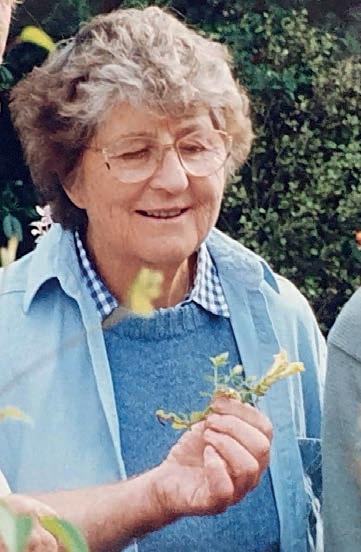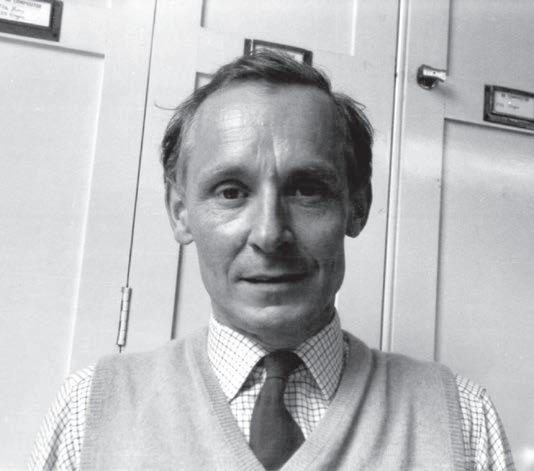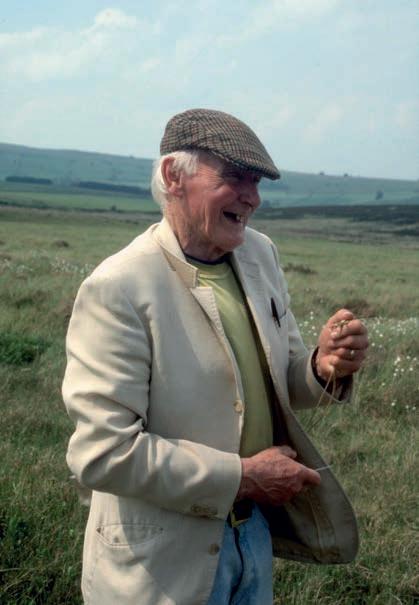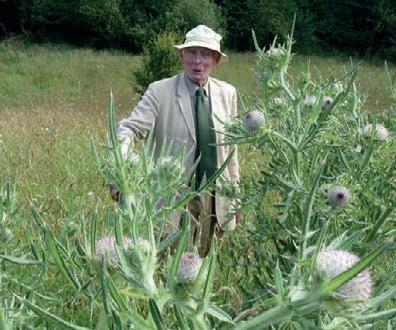
16 minute read
Compiled by Chris Preston
OBITUARIES
Compiled by Chris D. Preston, Obituaries Editor
Advertisement
19 Green’s Road, Cambridge CB4 3EF
cdpr@ceh.ac.uk
ANNE HORSFALL (1927–2021)
Anne Horsfall, who died on 24 June 2021, was a remarkable woman and respected amateur botanist. Perhaps because of poor health in her last decade, she had left the BSBI and she may now only be remembered by those who were her contemporaries, her family and many friends. However, her contribution to, and interest in, botany over her lifetime was great.
Anne came from a wealthy and high achieving background. Her father, Ewart, served in the Army and Royal Flying Corps in World War I in France, and was awarded both a Military Cross and a Croix de Guerre. He had won a Gold medal rowing in the 1912 Olympic Games in Stockholm, and after the war he won a Silver medal at Antwerp in 1920. Her mother, Myra, had a lifelong interest in travel and adventure. Anne inherited this stamina and ‘wanderlust’ from her parents. She was born on 27 March 1927 and grew up at the family home near Cheltenham, alongside her two older brothers. She went to Cheltenham Ladies’ College, and then on to Oxford, where she read Botany at Lady Margaret Hall, graduating with a Class III degree in 1949.
Anne first joined the BSBI in 1946 and attended a field meeting in Glen Affric in 1947, held to survey an area threatened by hydroelectric development. The other participants included a host of distinguished (or subsequently distinguished) botanists, including Maybud Campbell, Mary McCallum Webster, Canon Charles Raven, John Raven, Noel Sandwith, Douglas Simpson, Tom Tutin, Eleanor Vachell,Ted Wallace, Max Walters, ‘Heff’ Warburg and Alfred James Wilmott. She recalled some of the party going into huddles and heard that they were discussing Rum, but it was only when Karl Sabbagh’s book A Rum affair appeared in 1999 that she realised that they must have been discussing the remarkable
Anne Horsfall
Hebridean records emanating from Prof. J.W. Heslop Harrison and his team.
After graduating, Anne taught overseas for many years, first in Canada and then, drawn to Africa, in Uganda, Malawi and finally Kenya. Her brothers were farming there, and her last teaching post was quite close to them. Anne went on safaris all over East Africa during these post-war years. Since climbing was her main and favourite pastime she joined the Mountain Club of Kenya and climbed the Ruwenzoris, Mount Kenya and Kilimanjaro – the highest peaks in Africa. She had great physical and mental stamina, was a strong walker yet, as a
botanist, she always took time to observe the plants at every altitude.
Returning to England in the 1970s, Anne settled in Stoborough near Wareham, Dorset, in a house she inherited from her mother. Anne always claimed that Dorset had more flowering plants than any other county in England. The hectad in which she lived, SY98, certainly had the highest number of native species in the BSBI’s New Atlas survey, which appears to support her claim! Anne explored across the county, and soon became a recognised expert on the flora of Dorset. She was also a much-valued member of the Dorset Wildlife Trust (DWT), with which she was actively involved for over 40 years. She was on the DWT Committee, several of the DWT nature reserve management committees, and a leader of field excursions and surveys.
Anne’s curiosity for the nature around her, and her energy in exploring new places and finding new plants, was insatiable. As an educator she believed in sharing her knowledge and encouraging others in her passion for plants. She accompanied Butterfly Conservation transect walks and played a valuable role as plant identifier. She carried out an extensive fieldwork project, revisiting many of the localities that Ronald Good had surveyed in the 1930s when writing A Geographical Handbook of the Dorset Flora (1948). Anne’s observations of the changes in plants and habitats that had occurred in the intervening 40–50 years were published in a series of papers published in the Proceedings of the Dorset Natural History and Archaeological Society between 1981 and 1987, with a further paper on change in 1990. She also wrote papers on Dorset’s Domesday and medieval woodland (1997, 1998), two books, Names of wildflowers in Dorset (1991) and Discover Dorset: Woodlands (1997) and the chapters on coastal and woodland habitats in the DWT publication The Natural History of Dorset (1997).She also contributed captions for many species of Scrophulariaceae to the New Atlas (2002).
Anne was a modest but talented artist, who preferred to work with watercolours. She was inspired by Mary Grierson, and possibly her greatgreat-grandmother, Dorothy Horsfall, a notable flower illustrator. Her botanical/flower paintings were wonderful and many adorned the corridors of her house. She enjoyed attending the amateur painting courses in the local village hall, and happily rose to all the challenges set by the tutor, while enjoying the company of the other participants.
Anne’s home was immediately adjacent to Stoborough Heath NNR, and close to Hartland Moor NNR. The garden, though extensively planted with shrubs (rhododendrons, camellias, azaleas) and trees, with a pond, vegetable patch, and prized rockery, was latterly essentially left to be an extension of the heathland. The lawn was colonised by several species of orchid, which Anne loved, as well as ants that attracted Green Woodpeckers. As time passed and she was less able to get outside, the garden became even more wild. On one visit we counted eleven very large wood ant nests, and badgers had established a large sett. Once, when camping on her lawn, a mole made its presence known to us under the tent, and the churring of Nightjars finally brought sleep! While she was able Anne would delight in hunting for different fungi around the garden and identifying them all, and she kept an eye on the Dorset Heath (Erica ciliaris) and Marsh Gentian (Gentiana pneumonanthe) just beyond the fence. It was a naturalist’s paradise.
Despite her very close attachment to Dorset, its wildlife and conservation, Anne did not give up her travels in search of new places and plants, until ill-health prevented it. Expeditions included Afghanistan, the Nepal Himalaya, Egypt and Arabia, and the Antarctic; not forgetting a visit to the Highlands of Scotland for her favourite arcticalpines on Ben Lawers, and then north around Inverness, with Margaret Barron, then Recorder for Easterness.
Lastly, but by no means least, Anne was a caring sister, a no-nonsense aunt and cousin, full of fun and humour, happily sharing her knowledge and expertise throughout her life. She joined her family whenever possible; she bowled a mean ball at cricket, and when nearly 80, volunteered as goalie at one family Christmas football match. Remarkable indeed!
We thank the following for their contributions: Anne’s family, her friends, David Pearman (for the paragraph on the Glen Affric meeting), Nigel Webb (Trustee and former Chairman of the Dorset Wildlife Trust) and Hannah Wiler (Dorset Wildlife Trust).
Ron and Lynnette Youngman
ROBERT DESMOND MEIKLE, OBE, LLB (1923–2021)
R.D. Meikle, always known as Desmond, was one of the most important botanists of the last hundred years and a remarkable character. His superb scientific abilities are confirmed by the colleagues and botanists he helped, while affectionate stories of his charm, wry humour, loyal friendship and mischievous (though always kind) sense of humour would fill a volume the size of Stace 4!
In writing this obituary, we have found ourselves overwhelmed with good material. Within Somerset alone we have countless memories and botanical records. In 2014 when Desmond made the decision (after a shaking fall in his precipitous garden) to move into sheltered housing, he was very clear about his wishes and remained very lively and engaged until a final year of repeated illnesses. When he moved he told Jeanne and Tim Webb, with one of his rather toothless grins, ‘I intend to linger’ and to all of our delight he did just this. So this piece will attempt to honour his memory on many levels, of science, achievement, history and affection. With restricted space everyone’s favourite Meikle stories must be omitted but we have included brief quotations from the considerable correspondence we have received.
Desmond was born on 18 May 1923 in Newtownards, Co Down into a family with connections on both sides to the linen industry which was of major importance to Northern Ireland in the early 20th century – his father, George Mather Meikle, managed the Irish Tapestry Company which made household textiles. Sadly he died when Desmond and his twin brother Eric Alexander (younger by a couple of minutes) were only six years old, leaving them and their elder brother James Mather to be brought up by their mother Sydney (née Mulligan). She was an enormously beneficial influence in the

Desmond Meikle in the herbarium at Kew. Loutfy Boulos
lives of the boys. Part of her background was on the land, and after her husband’s death she became quite reclusive, spending all her time with her sons. This led to a key event in Desmond’s life. When he was nine Sydney took the twins to Kew Gardens for a holiday treat. Desmond was ‘entranced’, and afterwards called the gardens ‘paradise’. His mother also started him gardening and looking at local wild flowers. He always carried in his wallet a tattered scrap of paper with a poem ‘The Nature Lovers’ written out (and authored?) by her, and his lifelong passion for plants clearly owes much to this early influence. All his life he seems to have used her way of thinking as a touchstone for good.
He was tutored at home by an (obviously excellent) retired schoolmistress before going to the Royal Belfast Academical Institution and from there, in 1940, to Trinity College Dublin, achieving an entrance scholarship and a first class honours
degree. His subject in these years was law, and his excellent Latin already caused comment. In later years he was often called on to help more struggling linguists when they had to prepare the descriptions of new species. During the years in Dublin his plant interests also developed strongly through his contacts with the great A.W. Stelfox, and with Prof. H.H. Dixon who gave Desmond a privileged key to Trinity College Botanic Garden. After college he began work in the North as a solicitor, but started botanising in Co Fermanagh with three friends (also Ulstermen), Norman Carrothers, Jack Moon and Robert Davidson. This happy gang of musketeers explored the county flora for some twelve years, up to 1957, and they added some famously good plants to the county list, including Ranunculus lingua, Vaccinium oxycoccos and most notably Cirsium heterophyllum. ‘The foursome set a standard [of recording] that has been hard to equal and impossible to surpass’ according to Robert Northridge, though the ‘sense of fun and freedom’ given by the group’s adventures in the post-war years is also mentioned.
The most significant shift in Desmond’s life had come in 1946, when the gap he perceived between law and justice ‘disgusted’ him when working as a solicitor and he applied for an English Civil Service job. During the interview he was treated in an offhand, insulting way, and although he was offered the job shortly afterwards, it was too late – the guardian spirit of botany had intervened. Annoyed by his clash with bureaucracy, he went that afternoon to Kew to refresh his spirits in the gardens. There he met Ernest Nelmes (of sedge fame). They had corresponded and now talked. Nelmes, with supernatural foresight, said ‘Why don’t you get a job here?’. Edgar Milne-Redhead, then in charge of the Kew African Section, became involved and together they persuaded the Keeper of the Herbarium, Dr W.B. Turrill, to take Desmond on as a temporary assistant. He did not leave until his retirement in 1984!
Obituaries have appeared in various publications (including The Times and Irish Naturalists’ Journal) all giving details of his career and achievements. A notably beautifully-written one is by Belyaeva & Brough (2021). It includes twelve meticulously collated pages listing Desmond’s 96 publications (a very difficult task as Desmond himself said he couldn’t remember how many papers he had written), the 71 new taxa he described and his 58 new combinations and replacement names, 48 new combinations and replacement names based on the names he published and 10 plants named in his honour (he laughed about these, saying the plant was always the ugliest in its genus). There are also three unpublished works – these were two papers which exist as typescripts in the library at Kew, but the third is more important in this story.
Desmond wrote a fascinating, and in places outrageous, account of his life which he called Tantus Amor Florum, distributed to a few close friends with the warning that it must never be published. Of course it ‘escaped’ over the years, and after his death a surprising number of people told us about it and sent us the document. The Webbs, as his executors, decided to obey his wishes, so no extracts will appear here except for his mention in the introductory paragraph of his ‘love-affair with flowers’, and his statement ‘Deprived of flowers I should unquestionably die’. Mercifully he never lost their company, and one of the most touching elements of his memorial lunch was a ‘parish bunch’ assembled in the hall from different flowers brought by those attending.
His first big Kew task was to go to Nigeria to research the distribution and properties of Strophanthus sarmentosus, a vine containing chemicals thought to be of great medical value and also reported to be used by indigenous peoples as an arrow poison. Significant botanical discoveries were made but the research was finally aborted, leaving Desmond with ‘unfinished business’ which nagged him for the rest of his life. Back in England he was put in charge of the Europe and Orient (Middle East) section of the Herbarium. This first involved a rather unsatisfactory experience with a tricky sponsor for a Flora of the Greek island of Chios, but led eventually to the Flora of Cyprus, appearing in two volumes, the first in 1977 and the second in 1985. This flora is still praised and admired as a superlative work. Eric
Clement says that ‘the descriptions … are some of the best in any Flora’ and Arthur Chater regards it as ‘the model and best of what [such a work] should be’. Former Cypriot colleagues, including Dr Charalambos Christodoulou, told us that the two volumes are ‘definitely the Bible’ for them, ‘accomplished through the extensive knowledge, the hard work and the persevering insistence of Mr Meikle (qualities of his Irish DNA?)’.
These qualities also made a huge contribution to The Flora of County Fermanagh (2012) by R.S. Forbes and R.H. Northridge. Robert Northridge has written to us saying that the ‘thoroughness and accuracy of the [foundation] work of Desmond and his colleagues cannot be exaggerated’. Desmond’s mantra was always ‘Habitat, habitat’ habitat’ – an essential principle for all field botanists, and this fine Flora clearly confirms its importance to everyone involved.
The book best known to most of us is of course BSBI Handbook No 4 Willows and Poplars (1984). There have been considerable taxonomic developments since then, often involving Desmond himself collaborating with Dr Belyaeva and others, and naturally we all look forward to an eventual re-issue, but for nearly 40 years this has been a most notable prop and stay as we struggle with this difficult group.
As well as these major achievements Desmond was intimidatingly productive! He wrote many papers, edited the ‘Kew Series’ of handbooks, and was an important contributor as a member of the Editorial Committee of the International Code of Botanical Nomenclature. ‘To understand the taxonomic view of a scientist one must know the way of scientific thinking of that person and read between the lines of their publications. Desmond understood that taxonomy could not exist without nomenclature’ (Belyaeva & Craig, 2021) and many of his published papers utilise this understanding and knowledge.
His personal life was always more private. He married Carola Dickinson, the algologist at Kew, in 1960. After her death in 1970 he continued commuting between Kew and Wootton Courtenay


Top: Desmond Meikle botanising on a Cumbrian bog, June 2003. Bottom: with Cirsium eriophorum near Selworthy, Somerset. Jeanne Webb
until retiring in 1984. His garden was always a great pleasure and interest, and he played an active part in Somerset botanical recording, contributing both to The Atlas Flora of Somerset (1997) and the national ‘Atlas 2000’ scheme. Throughout his retirement years his unstinted kindness and knowledge were
shared at every opportunity, whether identifying a garden plant for a neighbour, teaching Jeanne willow knowledge for Somerset botanists to draw on in the future, or hosting a gloriously cheerful 90th birthday party with plenty of CAKE!
After Desmond’s death on 5 February 2021 there was a memorial lunch in Wootton Courteney – a lunch for botanist friends and colleagues and most importantly for his village neighbours – Desmond’s final party. It was a joyful occasion with good food, drink and flowers, and an evocative display of photographs, books and memorabilia. For the booklet given to participants Jeanne Webb wrote an excellent account of his life, and the structure of this obituary is based on this. When RF was given her copy she thought of how in Ireland a memorial event programme is ironically referred to as ‘the race-card’ and was sure Desmond would have enjoyed that.
The appreciative words used by our many correspondents would fill a thesaurus. Both Keith Ferguson and John McNeill, speaking at the memorial lunch, praised his generosity to them when they were starting out as shy new bugs at Kew. We can only end with our own gratitude for the years we knew him, full of laughs and wisdom. As Alan Leslie summed him up in an email ‘He was something of a legend, a real character and a fine botanist’. Thank you, Desmond!
Our thanks to Irina Belyaeva, Charalambos Christodoulou (with other Cypriot colleagues), Arthur Chater, John David, Gemma Douglas, Keith Ferguson, Georgios Hadjikyriakou, Nicholas Hind, Alan Leslie, Charles Nelson (remembering ‘uproarious lunches at Glasnevin’), Robert Northridge and Chris Preston.
Reference
Belyaeva, I.V. & Brough, C. 2021. Scientific heritage of
Robert Desmond Meikle (1923–2021). Skvortsovia 7(3): 24–43.
Ro FitzGerald and Jeanne Webb
OBITUARY NOTES
Since we compiled the last Obituary Notes, news has reached us of the death of the following members or former members. We send our sympathy to their families and friends.
Revd Michael H. Atkinson of Ilkley, West Yorkshire, a member for 36 years.
Miss Anne Horsfall of Stoborough, Dorset (see obituary in this issue).
Dr David R. Larner of High Peak, Derbyshire, a member for 47 years.
Mrs Yvonne Leonard of Mildenhall, Suffolk, a member from c.1990 to 2008.
Dr Norman K.B. Robson of Oxted, Surrey (and the Natural History Museum, London), a member for over 70 years, an honorary member since 1988 and referee for the genus Hypericum.
Mr Anthony H. Vaughan of Ottery St Mary, Devon (formerly of Builth Wells, Powys), a member for 65 years.
Mr Howard W. Wallis of Epsom, Surrey, a member for 2 years.
Chris D. Preston, Obituaries Editor
Assisted by the Membership Secretary, Gwynn Ellis. Date of compilation 26 November 2021.










